|
|
The Holy Martyrs Proclus and Hilarius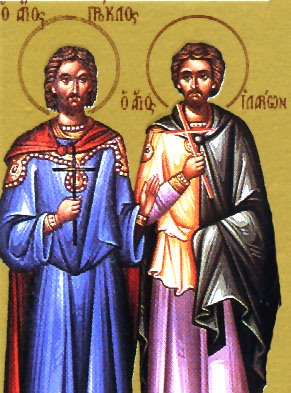 These martyrs were born in Kallippi in Asia, Proclus being Hilarius"s uncle. They suffered in the time of Trajan. The judge asked Proclus: "Of what race are you?" Proclus replied: "I am of the race of Christ, and my hope is in my God." When the judge threatened him with torture, he said: "When you are afraid to transgress the Emperor"s commands and risk falling into temporal punishment, how much more do we Christians fear to transgress against God"s commands and fall into eternal torment!" While Proclus was being tortured, Hilarius came up to the judge and said: "I too am a Christian!" After many tortures, the two of them were condemned to death, Proclus being crucified and Hilarius beheaded with the sword. They both entered into the joy of their Lord. These martyrs were born in Kallippi in Asia, Proclus being Hilarius"s uncle. They suffered in the time of Trajan. The judge asked Proclus: "Of what race are you?" Proclus replied: "I am of the race of Christ, and my hope is in my God." When the judge threatened him with torture, he said: "When you are afraid to transgress the Emperor"s commands and risk falling into temporal punishment, how much more do we Christians fear to transgress against God"s commands and fall into eternal torment!" While Proclus was being tortured, Hilarius came up to the judge and said: "I too am a Christian!" After many tortures, the two of them were condemned to death, Proclus being crucified and Hilarius beheaded with the sword. They both entered into the joy of their Lord.Our Holy Father Michael Maleinos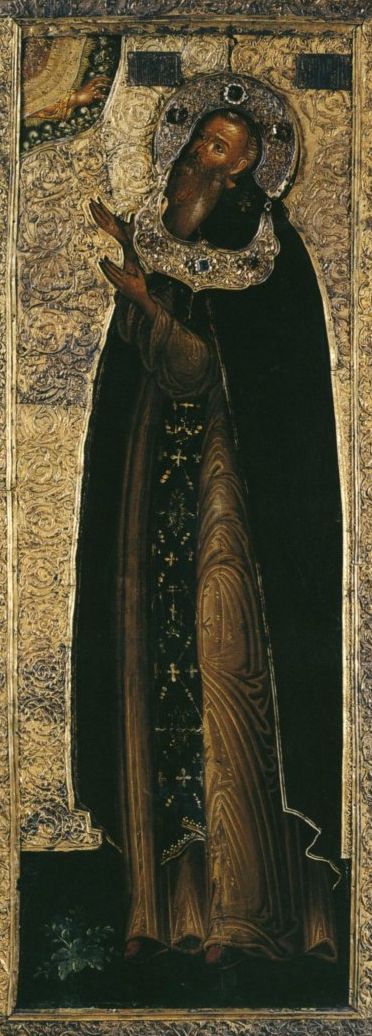 He was a wealthy man of noble birth. Scorning worldly goods in his youth, he withdrew to Mount Kyminas in Bithynia, where he lived in asceticism, purifying his heart by fasting and prayer. He later had many disciples, of whom the best-known is St Athanasius the Athonite. He died peacefully in the middle of the tenth century. He was a wealthy man of noble birth. Scorning worldly goods in his youth, he withdrew to Mount Kyminas in Bithynia, where he lived in asceticism, purifying his heart by fasting and prayer. He later had many disciples, of whom the best-known is St Athanasius the Athonite. He died peacefully in the middle of the tenth century.The Holy Martyr Golinduc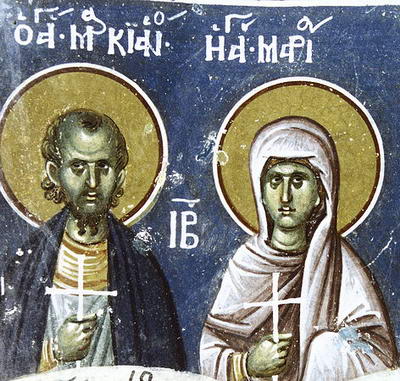 A Persian, she married a Persian noble and lived three years in wedlock. She then had a vision of an angel, who revealed the other world to her: the torment of sinners and unbelievers and the joy of the righteous. She left her husband and received baptism, being given the name Maria. As a result of her husband"s persecution, she was condemned to lifelong imprisonment and spent eighteen years in prison, being steadfast in the Faith. She was then thrown into a pit, but was saved by God; then before a venomous snake, but the snake did not harm her. When some wicked youths were sent to her to defile her, God made her invisible to their eyes. Amazed at her sufferings, many Persians were converted to the Christian faith. She visited Jerusalem, where she denounced the Severian heresy which taught that Christ"s divinity suffered, and therefore recited the Trisagion in this form: "Holy God, Holy and Strong, Holy and Immortal, crucified for us, have mercy on us." Preaching the true Faith up to the end of her life, she died peacefully near the town of Nisibis in 587. A Persian, she married a Persian noble and lived three years in wedlock. She then had a vision of an angel, who revealed the other world to her: the torment of sinners and unbelievers and the joy of the righteous. She left her husband and received baptism, being given the name Maria. As a result of her husband"s persecution, she was condemned to lifelong imprisonment and spent eighteen years in prison, being steadfast in the Faith. She was then thrown into a pit, but was saved by God; then before a venomous snake, but the snake did not harm her. When some wicked youths were sent to her to defile her, God made her invisible to their eyes. Amazed at her sufferings, many Persians were converted to the Christian faith. She visited Jerusalem, where she denounced the Severian heresy which taught that Christ"s divinity suffered, and therefore recited the Trisagion in this form: "Holy God, Holy and Strong, Holy and Immortal, crucified for us, have mercy on us." Preaching the true Faith up to the end of her life, she died peacefully near the town of Nisibis in 587.St Veronica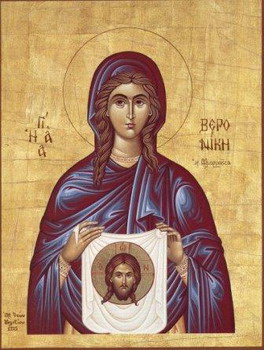 This is the woman with the issue of blood, whom the Lord healed (Matt. 9:20). In gratitude to the Lord her healer, Veronica caused a statue of the Lord Jesus to be made, before which she prayed to God. By tradition, this statue was preserved up to the time of Julian the Apostate, when it was altered to become a statue of Zeus. This is one of the very rare occasions that a holy statue has been used in the Eastern Church. As is known, this later became a common custom in the Western Churches. St Veronica remained faithful to Christ till death, and entered peacefully into rest. This is the woman with the issue of blood, whom the Lord healed (Matt. 9:20). In gratitude to the Lord her healer, Veronica caused a statue of the Lord Jesus to be made, before which she prayed to God. By tradition, this statue was preserved up to the time of Julian the Apostate, when it was altered to become a statue of Zeus. This is one of the very rare occasions that a holy statue has been used in the Eastern Church. As is known, this later became a common custom in the Western Churches. St Veronica remained faithful to Christ till death, and entered peacefully into rest.The Holy Martyrs Theodore and John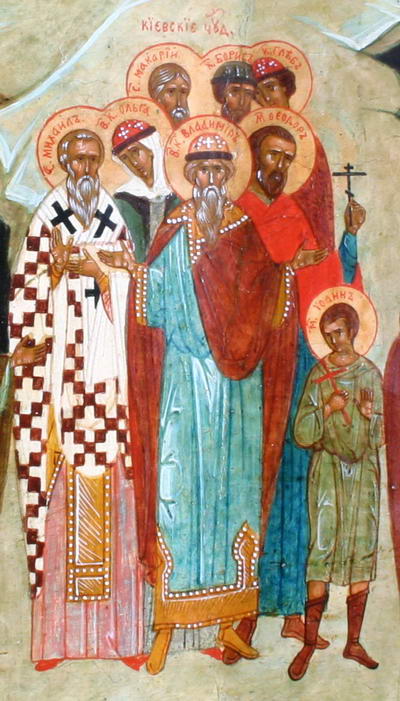 Father and son, they settled after their baptism in the pagan city of Kiev. The infuriated pagans pulled their house down about their ears, and the two of them perished for the sake of Christ. Their relics are preserved in St Antony"s caves. The barren and women who miscarry pray especially to them. Father and son, they settled after their baptism in the pagan city of Kiev. The infuriated pagans pulled their house down about their ears, and the two of them perished for the sake of Christ. Their relics are preserved in St Antony"s caves. The barren and women who miscarry pray especially to them.Icon of the Mother of God of 'the Three Hands'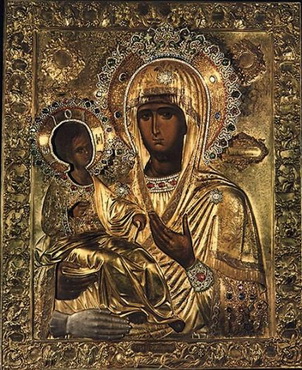 The Icon of the Mother of God, “Of the Three Hands”: In the eighth century during the time of the Iconoclasts, St. John of Damascus (December 4) was zealous in his veneration of holy icons. Because of this, he was slandered by the emperor and iconoclast Leo III the Isaurian (717-740), who informed the Damascus caliph that St. John was committing treasonous acts against him. The caliph gave orders to cut off the hand of the monk and take it to the marketplace. Towards evening St. John, having asked the caliph for the cut-off hand, put it to its joint and fell to the ground before the icon of the Mother of God. The monk begged Our Lady to heal the hand, which had written in defense of Orthodoxy. After long prayer he fell asleep and saw in a dream that the All-Pure Mother of God had turned to him promising him quick healing.
Before this the Mother of God bid him toil without fail with this hand. Having awakened from sleep, St. John saw that his hand was unharmed. In thankfulness for this healing St. John placed on the icon a hand fashioned of silver, from which the icon received its name “Of Three Hands.” (Some iconographers, in their ignorance, have mistakenly depicted the Most Holy Theotokos with three arms and three hands.) According to Tradition, St. John wrote a hymn of thanksgiving to the Mother of God: “All of creation rejoices in You, O Full of Grace,” which appears in place of the hymn “It is Truly Meet” in the Liturgy of St. Basil the Great.
St. John Damascene accepted monasticism at the monastery of St. Sava the Sanctified and there bestowed his wonderworking icon. The Lavra presented the icon “Of Three Hands” in blessing to St. Sava, Archbishop of Serbia (+ 1237, January 12). During the time of an invasion of Serbia by the Turks, some Christians who wanted to protect the icon, entrusted it to the safekeeping of the Mother of God Herself. They placed it upon a donkey, which without a driver proceeded to Athos and stopped in front of the Hilandar monastery. The monks put the icon in the monastery’s cathedral church (katholikon). During a time of discord over the choice of igumen, the Mother of God deigned to head the monastery Herself, and from that time Her holy icon has occupied the igumen’s place in the temple. At the Hilandar monastery there is chosen only a vicar, and from the holy icon the monks take a blessing for every obedience.
In Slavic usage, this Icon is commemorated on July 12. The Icon of the Mother of God, “Of the Three Hands”: In the eighth century during the time of the Iconoclasts, St. John of Damascus (December 4) was zealous in his veneration of holy icons. Because of this, he was slandered by the emperor and iconoclast Leo III the Isaurian (717-740), who informed the Damascus caliph that St. John was committing treasonous acts against him. The caliph gave orders to cut off the hand of the monk and take it to the marketplace. Towards evening St. John, having asked the caliph for the cut-off hand, put it to its joint and fell to the ground before the icon of the Mother of God. The monk begged Our Lady to heal the hand, which had written in defense of Orthodoxy. After long prayer he fell asleep and saw in a dream that the All-Pure Mother of God had turned to him promising him quick healing.
Before this the Mother of God bid him toil without fail with this hand. Having awakened from sleep, St. John saw that his hand was unharmed. In thankfulness for this healing St. John placed on the icon a hand fashioned of silver, from which the icon received its name “Of Three Hands.” (Some iconographers, in their ignorance, have mistakenly depicted the Most Holy Theotokos with three arms and three hands.) According to Tradition, St. John wrote a hymn of thanksgiving to the Mother of God: “All of creation rejoices in You, O Full of Grace,” which appears in place of the hymn “It is Truly Meet” in the Liturgy of St. Basil the Great.
St. John Damascene accepted monasticism at the monastery of St. Sava the Sanctified and there bestowed his wonderworking icon. The Lavra presented the icon “Of Three Hands” in blessing to St. Sava, Archbishop of Serbia (+ 1237, January 12). During the time of an invasion of Serbia by the Turks, some Christians who wanted to protect the icon, entrusted it to the safekeeping of the Mother of God Herself. They placed it upon a donkey, which without a driver proceeded to Athos and stopped in front of the Hilandar monastery. The monks put the icon in the monastery’s cathedral church (katholikon). During a time of discord over the choice of igumen, the Mother of God deigned to head the monastery Herself, and from that time Her holy icon has occupied the igumen’s place in the temple. At the Hilandar monastery there is chosen only a vicar, and from the holy icon the monks take a blessing for every obedience.
In Slavic usage, this Icon is commemorated on July 12. Martyr Mamas near Sigmata
New Martyrs Andrew the Soildier, Heraclius, Taustus, Menas, and others
Blessed Serapion, bishop of Vladimir (1275)
Venerable Arsenius of Novgorod, fool-for-Christ (1570)Venerable Simon, abbot of Volomsk (1641)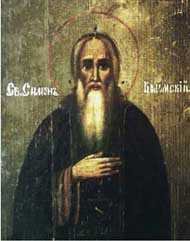 The MonkMartyr Simon of Volomsk, in the world Simeon, son of the peasant Mikhail from the vicinity of Volokolamsk, was born in the year 1586. At 24 years of age, after long pilgrimage through Orthodox monasteries, he took monastic vows at the Pinegsk Makar'ev monastery, and in the year 1613 he settled 80 versts to the southwest of Ustiug at the River Kichmenga, in the Volomsk forest. Here he spent five years alone, remote from people; he nourished himself with vegetables which he himself cultivated, and sometimes indeed asked for bread in some settlement. When lovers of the quiet life began to gather to him, the Monk Simon, through a grant of tsar Mikhail Feodorovich and with the blessing of the Rostov metropolitan Varlaam, erected a temple in honour of the Cross of the Lord, and in 1620 was made head of the monastery founded by him. A strict ascetic, serving as an example to all in virtue, love of toil, fasting and prayer, he was wickedly murdered in his own monastery on 12 July 1641. The body of the Monk Simon with reverence was buried on the left side of the church built by him.
Veneration of the monk began in 1646 after gracious manifestations witnessed to of his relics. His life was compiled in the XVII Century. The MonkMartyr Simon of Volomsk, in the world Simeon, son of the peasant Mikhail from the vicinity of Volokolamsk, was born in the year 1586. At 24 years of age, after long pilgrimage through Orthodox monasteries, he took monastic vows at the Pinegsk Makar'ev monastery, and in the year 1613 he settled 80 versts to the southwest of Ustiug at the River Kichmenga, in the Volomsk forest. Here he spent five years alone, remote from people; he nourished himself with vegetables which he himself cultivated, and sometimes indeed asked for bread in some settlement. When lovers of the quiet life began to gather to him, the Monk Simon, through a grant of tsar Mikhail Feodorovich and with the blessing of the Rostov metropolitan Varlaam, erected a temple in honour of the Cross of the Lord, and in 1620 was made head of the monastery founded by him. A strict ascetic, serving as an example to all in virtue, love of toil, fasting and prayer, he was wickedly murdered in his own monastery on 12 July 1641. The body of the Monk Simon with reverence was buried on the left side of the church built by him.
Veneration of the monk began in 1646 after gracious manifestations witnessed to of his relics. His life was compiled in the XVII Century.Venerables John (998) and Gabriel (10th c.), of Georgia and Iveron, Mt. Athos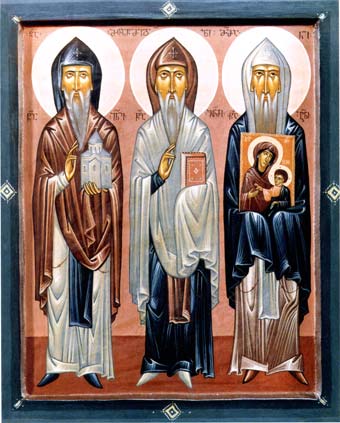 Saint John was born the son of a nobleman during the reign of King Davit Kuropalates. For his love of Christ he left his family and the world to be tonsured a monk. After informing the royal court of his decision, St. John received a blessing from his spiritual father to travel to Greece, where he settled at a monastery on Mt. Olympus... Saint John was born the son of a nobleman during the reign of King Davit Kuropalates. For his love of Christ he left his family and the world to be tonsured a monk. After informing the royal court of his decision, St. John received a blessing from his spiritual father to travel to Greece, where he settled at a monastery on Mt. Olympus...Translation of the relics (2004) of New Hieromartyr Momcilo Grgurevic of Serbia (1940s)
|